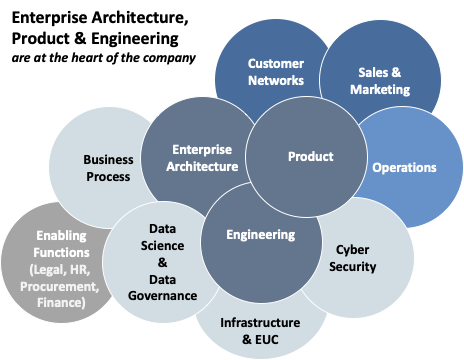A Product-Aware Organisational Structure
We believe that time-honoured organisational structures and funding methods are no longer relevant. In order to create a customer-centric business it's time to pivot the organisation and place Enterprise Architecture, Product Management and Engineering at the heart of the company.

Time-honoured organisational structures and funding methods are no longer as relevant as they once were. In order to create a customer-centric business it's time to pivot the organisation and place Enterprise Architecture, Product Management and Engineering as the engine-room of the internal value chain, led by a CDIO.
A product-aware organisation is one which is set-up to create products (and services) which are ready to deliver value to customers.
This means that Busness Product Owners decide what will be valuable, and will work with the rest of the business to see that the value is delivered.
Each Product Owner has a cross-functional team who constantly iterate through new implementations of the product, each containing an incremental improvement on the value delivered to the customer.
This team is sized to include all of the organisational skills needed to deliver these product increments. In effect the team members are ring-fenced and work for the Product Owner irrespective of their subject matter skill.
Further, this team is funded by Opex. It no longer makes sense to make investment decisions at the granularity of “projects”; nor to determine success or failure, status or progress, based on Capex funded projects.
The organisation should be sized, staffed and funded to deliver the products which embody its Why
Organisational Capabilities
The graphic below puts the three key organisational capabilities of a customer-centric organisation at the heart of company activity.

The Product and Enterprise Architecture teams must work together to provide clarity on what Engineering will do. This triage is key to success.
Engineering is a reimagined IT where the teams are organised in squads of ringfenced and cross-functional SMEs, given direction by a Business Product Owner.
What is left in IT is only the commodity infrastructure and end-user computing. And as much of that as possible should transition to Infrastructure, Platform and Systems ‘as-a-service’.
Next:
We discuss how each major cross-functional capability works in a customer-centric world in these other posts:





